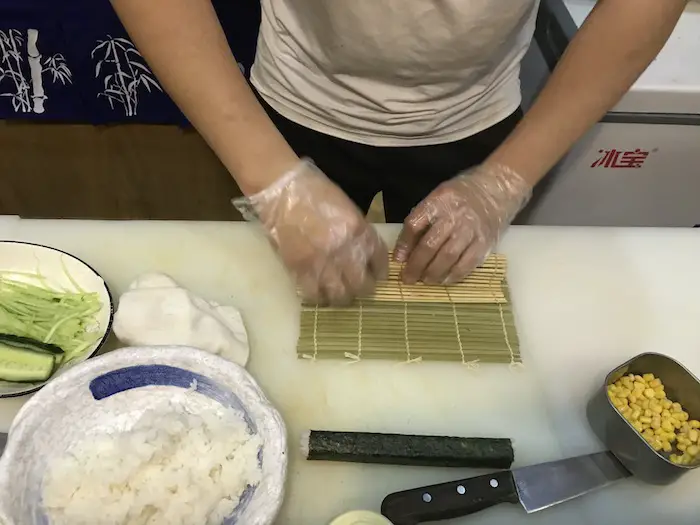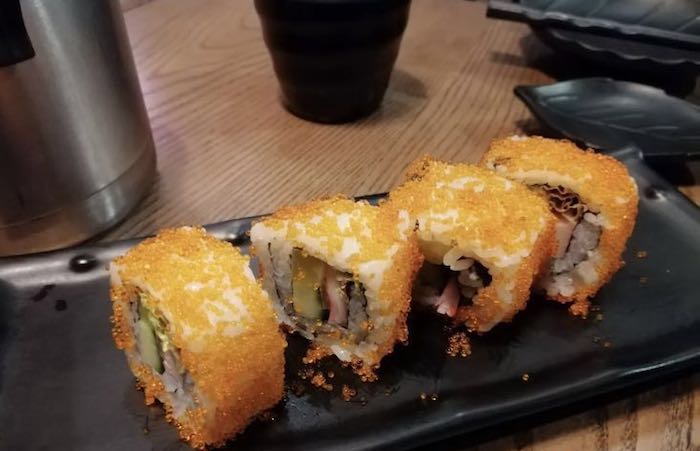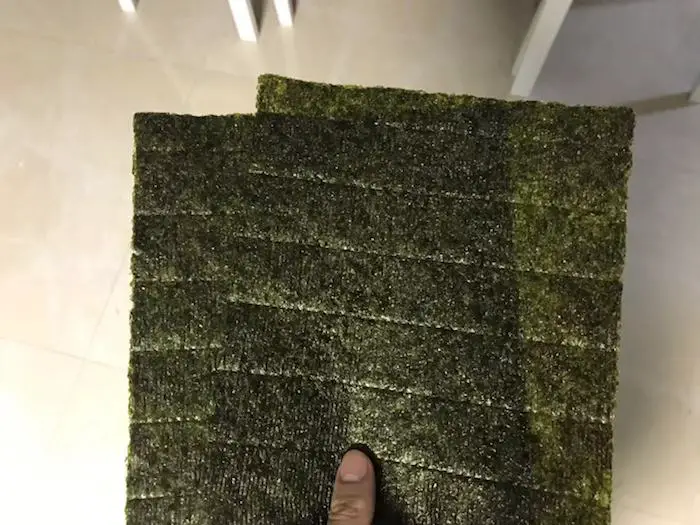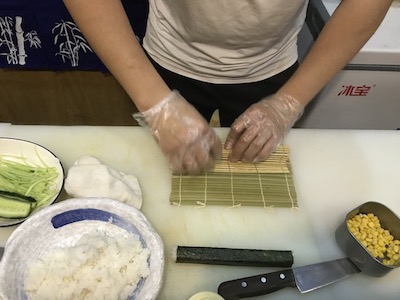We are reader supported. When you purchase through links on our site, we may earn an affiliate commission. Also, as an Amazon affiliate, we earn from qualifying purchases.

Making sushi at home may appear like a tough thing to try but trust me that rolling is the hardest part of all. You can make perfect sushi rice with some practice and you may be excused for not cutting fish and veggies like a chef. After all, you don’t care much about the presentation at home.
One thing my friends always ask me is ‘how do you make sushi rolls (really) tight? Well, the answer is pulling the end of the bamboo mat(makisu) near you to cover the sushi rice and toppings completely. Tighten further by pulling the makisu closer to you and then rolling it over the end and sealing the edges.
All it needs is a bit of practice to make a compact and tight roll so that the ingredients don’t fall apart. I would suggest that you don’t tighten the maki too much or else the rice may get crushed. The key lies in a perfect balance of sushi rice and fillings. And, did I mention patience? You need a lot of them.
Density Plays A Key Role In Tightening The Roll
If the rice is too dense, the result will not be very impressive. You can try a Japanese-style test of density by pouring some shoyu through one end of the sushi roll. It should pour out of the other side of the maki, otherwise, the roll is considered to be too dense.
This is where experience comes into play. Experienced sushi chefs know exactly how much rice and fillings can stand together in a compact shape. Make sure you do not press a lot of rice on the Nori sheet. It should be just enough depending on the size of the Nori you use.
The rule is similar to the case of nigirizushi. Too dense sushi rice is the sign of a beginner who still needs more practice to keep the roll from falling apart.
Making Sushi Rolls Tight Without A Bamboo Mat
Well, it may seem like it is almost impossible to make sushi roll tight without a mat but it is possible and I will show you how. So, if you don’t have a bamboo mat at home or it’s simply not your thing, you may still make tight and delicious maki rolls.
You can substitute the mat with a thick kitchen towel. Yes, a towel can be your savior! After you have cooked sushi rice and cut the veggies of your choice, lay the kitchen towel flat on the table. Then keep the Nori sheet, rough side facing upwards.
Now, lift the end of the towel closer to you and start rolling just like you do in the case of a bamboo mat. Some people prefer the towel over bamboo mat because it also helps in cleaning up the mess after the work is done.
Now, here comes the surprise.

If you thought towels can only be used for making traditional maki rolls and you are out of luck if you plant to eat California rolls for dinner then here’s a surprise for you. With a plastic cling film covering the towel, you can also make tight California rolls.
You just need to place the towel on the kitchen counter and cover it with a plastic sheet. Now keep the Nori over the plastic (any side facing up because it will be hidden inside anyway). Take a medium ball of sushi rice and layer it over the Nori sheet. Flip over the Nori to have the rice layer at the bottom.
Arrange the fillings over the Nori sheet and pull the side of the towel closer to you to make a tight cylindrical roll. You may even top off the sushi roll with avocado slices to create a dragon roll, read the recipe here. Use the towel once again to flatten the avocado slices over the roll and deliver a ‘wow’ effect.
Beyond The Sushi Mat – Rice, Nori, and Fillings
When talking about how to make sushi rolls tight, we usually talk about the mat used for rolling. However, let’s not forget that there are other things that make sushi easy or difficult to roll tightly. If you want to perfect the art of making compact sushi rolls, you will need to take care of these things too.
Sushi Rice
The base filling of the sushi is sushi rice and it helps in balancing the flavor and texture. It also helps in rolling very tightly when cooked correctly. When preparing sushi at home, always choose the short-grain Japanese rice as it is starchier, hence stickier than long grain versions.
The first step for making any type of sushi is to cook perfect sushi rice and you will find instructions on how much water to use and how to cook rice in cooker and pot here. Next step is to add rice vinegar to season the sushi rice. It helps in enhancing the flavors and lends cohesiveness to help you hold it together in the shape of a ball.
If you are a beginner, start with the simple cucumber maki roll and learn the technique to cook rice firmly, not mushy. The amount of water added while cooking and the duration for which the rice cooks determine the firmness. Make sure you allow the rice to cool off completely before using.
Nori (seaweed)

Nori is the seaweed parchment paper used for holding the sushi rice and ingredients together. You will find Nori sheets in any Asian grocery store that stocks soy sauce and sushi rice. You must buy a good quality Nori that is thick enough to not break down when rolled.
If you buy a thin Nori sheet, it may be too brittle and fall apart when trying to roll tightly. Even though the Nori is hidden in a California roll, it still plays a major part in giving your roll a compact shape.
See more: Good Nori, Bad Nori, & How to Tell the Difference
Selecting the right fillings
While sushi is admirable for its ability to accommodate any type of fillings inside it, let’s not forget that some fillings will be difficult to roll than others. If you are a beginner, there may be some types of fillings that you will be able to handle better.
Whether you use sushi-grade fish or vegetables, they can be cut into strips and lined lengthwise to ensure that your sushi looks uniform and nice. You can also experiment with different combinations but I would recommend cucumber and avocado for beginners. Mango and other slimy fruits are best left to seasoned chefs or home cooks.
You may try semi-boiled carrots and red bell peppers for a pop of color. Tuna and salmon are good meaty options. I would recommend beginners to avoid using cream cheese as it can make your sushi tough to roll tightly.
Fish and seafood fillings used in sushi rolls may be raw or cooked before using. If it’s raw, always buy the sushi-grade quality from a reliable source. If the fish looks slimy or off, steer away from consuming it. I would also recommend you to avoid fish with slimy meat unless you have good practice in making rolls tight.
As a beginner, it is better to avoid eel and octopus as they are slimy varieties. Some of the sushi-friendly fillings are cabbage, cucumber, bell pepper, tuna, surimi (imitation crab sticks), tuna, and boiled eggs. There are limitless options whether you are a carnivore, vegan or vegetarian.
Related Questions
Do I need a half or full Nori sheet?
This may depend upon the number of fillings and your personal preference for the taste of Nori. If you are making a fat roll with many ingredients (futomaki), you will need a full Nori sheet. If you are a beginner, I would recommend that you use only one or two ingredients and practice rolling in half Nori sheet.
To break the Nori sheet into half, fold it from the middle and press along the seams to get two equal halves. If you want a smoother edge, run a sharp Japanese knife along the lines.
Which side of the Nori should I start rolling?
If you are making sushi rolls by hand, start from the side that is covered with sushi rice so that you can easily seal on the side that has no rice in it. Press gently on the other side with moist fingers to make a tight roll.
Should I roll away or towards myself?
If you are a beginner, you will benefit from rolling the sushi roll towards you as it helps you spot any mistakes and correct them. The trained sushi chefs, on the other hand, prefer to roll away from them to get better control on the rolling process with their index fingers.
Is it possible to make tighter rolls with sushi making kits?
As beginners, you may face trouble making sushi rolls tight enough to not fall apart and look in good shape when served. You may use some of these quality sushi making kits reviewed by me to take the guesswork out of rolling and make it feel like a breeze.

